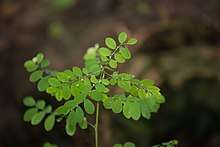Phyllanthus tenellus
Phyllanthus tenellus is a herbaceous plant in the leafflower family, Phyllanthaceae. It is commonly called Mascarene Island leaf flower[1] as it is native to the Mascarene Islands.[3] It is often a weed in flower beds, gardens, roadsides, and other disturbed areas.[3]
| Phyllanthus tenellus | |
|---|---|
 | |
| Phyllanthus tenellus leaves, flowers, and fruits | |
| Scientific classification | |
| Kingdom: | Plantae |
| Clade: | Tracheophytes |
| Clade: | Angiosperms |
| Clade: | Eudicots |
| Clade: | Rosids |
| Order: | Malpighiales |
| Family: | Phyllanthaceae |
| Genus: | Phyllanthus |
| Species: | P. tenellus |
| Binomial name | |
| Phyllanthus tenellus | |
| Synonyms[2] | |
| |
Description
It grows to be 20–50 cm (7.9–19.7 in) tall.[3] The main stem does not have leaves but rather small scales (see phyllanthoid branching) and the secondary stems contain the flowers and leaves.[3] The flowers are inconspicuous, small, and unisexual. Male and female flowers are on located on the same plant.
Taxonomy
It was originally published in William Roxburgh's 1814 Hortus Bengalensis[4] (as a nomen nudum) and later validated in his 1832 Flora Indica.[5][6]
Distribution
In addition to the Mascarene Islands, P. tenellus is possibly also native to eastern Africa, other western Indian Ocean islands, and the Arabian Peninsula.[3] It has become a naturalized weed in tropical and subtropical areas, including Australia, Mexico, South America, Eastern North America (from Florida to Virginia west to California), as well as parts of Asia and the West Indies.[3]
Bibliography
- Weakley, Alan (2015). Flora of the Southern and Mid-Atlantic States. Chapel Hill North Carolina: The University of North Carolina Herbarium.
- "Phyllanthus tenellus Roxb". Plants of the World Online. Royal Botanical Gardens Kew. Retrieved 2018-11-02.
- Levin, Geoffrey A. (2016). "Phyllanthus tenellus". In Flora of North America Editorial Committee (ed.). Flora of North America North of Mexico (FNA). 12. New York and Oxford. Retrieved 2018-11-02 – via eFloras.org, Missouri Botanical Garden, St. Louis, MO & Harvard University Herbaria, Cambridge, MA.
- Roxburgh, William (1814). Hortus Bengalensis, or a Catalogue of the Plants Growing in the Hounourable East India Company's Botanical Garden at Calcutta. Royal Botanic Garden, Calcutta. p. 69. Retrieved 2018-11-02.
- Roxburgh, William (1832). Flora Indica; or, Descriptions of Indian Plants. Serampore. p. 668. Retrieved 2018-11-02.
- "Hortus Bengalensis, or a Catalogue of the Plants Growing in the Hounourable East India Company's Botanical Garden at Calcutta. Serampore". ipni.org. International Plant Names Index. Retrieved 2018-11-02.